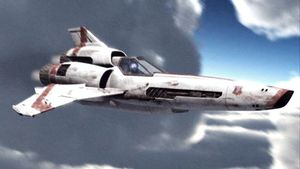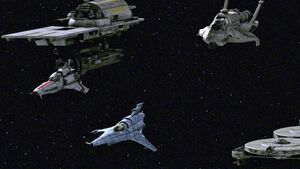Viper (TRS)
More languages
More actions
- This is an overview page on the subject of Viper fighter craft. For detailed information, see Viper Mark II and Viper Mark VII.
The Viper is the Colonial Fleet's primary space superiority fighter/attack craft, serving the fleet in both Cylon engagements. It dates back to Caprica before the formation of the Government of the Twelve Colonies when Vipers were primarily atmospheric aircraft.
Early Vipers
- See also Caprican Viper and Vintage Viper

Vipers are in service prior to the formation of the Colonial Fleet, serving the Caprican Military long before the First Cylon War.
Atmospheric Vipers in the form of propeller aircraft and jet-powered aircraft are utilized on Caprica decades before the Fall of the Twelve Colonies. Equipped with DRADIS technology, these early Viper jets are popular with holoband users, available for flight simulations in the virtual world (CAP: "The Imperfections of Memory"). Earlier Vipers are also appear in the popular hacked environment, New Cap City (CAP: "There is Another Sky", "The Imperfections of Memory", "Ghosts in the Machine").
Later Models

The Viper Mark II is the Colonial Fleet's mainstay fighter during the First Cylon War, serving with distinction throughout that conflict. Subsequently retired and replaced with newer models, Mark IIs survive into the modern era in museums - an entire squadron on display aboard the museum ship battlestar Galactica - and rusting in shipyards (TRS: Miniseries). Ten years into the First Cylon War the Viper Mark III was also put into service.
By the time of the Fall of the Twelve Colonies, the Viper Mark VII has taken up the mantle of the Mark II. However, due to its advanced construction and computer system, the standard Mark VII is vulnerable to the Cylon computer virus (TRS: Miniseries).
Flight Regimes

The Viper is designed to operate in both space and atmospheric conditions.
In space flight, the Viper is highly maneuverable, dangerously so in inexperienced hands. Reaction control system (RCS) thrusters for rapid and flexible attitude control, a cluster of 3 main thrusters for high acceleration, and retractable reverse thrusters housed in both port and starboard cowlings for some degree of deceleration can subject the pilot to punishing g-forces. Its retractable landing struts can be magnetized to secure the Viper on metal decks and surfaces in zero gravity.
In atmospheric flight, Vipers consume more Tylium fuel than in the vacuum of space. Once in an atmosphere, the engines must run continuously to maintain sufficient airflow over the wing lifting surfaces. Depending on the composition of the atmosphere itself, this can place severe strain on the Viper's engines (TRS: "You Can't Go Home Again"). In addition to greater fuel consumption, the high wing load (i.e. small wing area relative to weight) may compromise the Viper's overall maneuverability. Because the smaller wing surfaces generate less lift, higher speeds are needed to stay aloft. The fighter's RCS thrusters might partially compensate for this.
Life Support
Viper cockpits are pressurized and heated, and pilots wear flight suits which, along with a breathing pack housed within the back, provide full life support should ejection be required (TRS: "You Can't Go Home Again)". In atmospheric ejections, the seat jettisons automatically once clear of the Viper, exposing a parachute which is deployed at a safe altitude (TRS: "Act of Contrition", "Razor").
Viper cockpits are also hardened against radiation, including a canopy made of a radiation-resistant glass and is capable of protecting a pilot against radiation levels that would kill a healthy human in 30 seconds (Blood and Chrome)
Because of the stamina required to operate Vipers, battlestars have a specialized weight room where the pilots maintain their physical condition.
<pagesidebar>
- See Also
- Viper Mark II|Mark II Viper
- Viper Mark VII|Mark VII Viper
- Other Series
- Viper (TOS)|Original Series Viper
- Viper (1980)|Galactica 1980 Viper
</pagesidebar>
